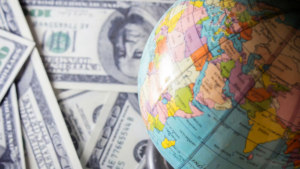Lakes are among the most beautiful natural features of our planet. They are vital sources of water, home to many plants and animals and provide stunning views. The Caspian Sea remains the largest lakes in the world by surface area. Below is a list of the top-10 largest lakes in the world with their unique characteristics.
World’s Largest Lake 2024
The Caspian Sea, renowned as the largest lake in the world, boasts an impressive area of 389,000 square kilometers (150,000 square miles). Stretching over a length of 1,119 kilometers (745 miles) and reaching a depth of 1,025 meters (3,365 feet), this water lake holds a volume of 78,200 cubic kilometers (18,800 cubic miles). Positioned at the crossroads of Eastern Europe, West Asia and Central Asia, the Caspian Sea is unique in its nature, resembling both a lake and a sea.
Geographical Features of Caspian Sea
The Caspian Sea is considered unique because of its vast size and unusual characteristics:
- Length and Shoreline: It has a maximum length of 1,030 km and a shoreline of about 7,000 km.
- Depth: The average depth is 211 meters, with some parts reaching much deeper.
- Primary Inflows: Major rivers like the Volga, Ural, Kura and Terek flow into the Caspian Sea,
- Islands: The sea has numerous islands, mostly near the coast. The largest island is Ogurja Ada.
Interesting Facts About World’s Largest Lake
Here are some key facts that you must know about the Caspian Sea, the world’s largest lake:
- The Caspian Sea holds 40-44% of the world’s total lake waters.
- It is classified as an endorheic basin, meaning it has no outflow to other water bodies.
- The seabed of the Caspian is the second-lowest natural depression on Earth.
Top-10 Largest Lakes in the World By Surface Area 2024
Caspian Sea, with an area of 389,000 square kilometers, stands as the largest lake in the world by surface area, followed by Superior Lake, Victoria Lake and Huron Lake.
Here is the list of Top 10 Largest Lake in the world by area:
| S. No. | Name | Countries with shoreline | Type | Area (in sq. km) | Length (in km) | Max. depth (in m) | Volume (in cube km) |
| 1. | Caspian Sea | Kazakhstan, Turkmenistan, Azerbaijan, Russia, Iran | Saline 1.2% | 389,000 | 1,199 km | 1,025 | 78,200 |
| 2. | Superior Lake | Canada, United States | Fresh | 82,100 | 616 | 406 | 12,070 |
| 3. | Victoria Lake | Tanzania, Uganda, Kenya | Fresh | 59,940 | 322 | 81 | 2,420 |
| 4. | Huron Lake | Canada United States | Fresh | 59,590 | 332 | 229 | 3,520 |
| 5. | Michigan Lake | United States | Fresh | 58,030 | 494 | 282 | 4,930 |
| 6. | Tanganyika Lake | Tanzania, Democratic Republic of Congo, Burundi, Zambia | Fresh | 32,900 | 676 | 1,470 | 18,750 |
| 7. | Baikal Lake | Russia | Fresh | 31,722 | 636 | 1,642 | 23,610 |
| 8. | Great Bear Lake | Canada | Fresh | 31,153 | 373 | 446 | 2,234 |
| 9. | Malawi Lake | Malawi, Mozambique | Fresh | 29,600 | 579 | 706 | 8,640 |
| 10. | Great Slave Lake | Canada | Fresh | 27,200 | 480 | 614 | 1,115 |
Largest Lake in the World, Caspian Sea
- Area: 389,000 sq. km (150,000 sq. mi)
- Length: 1,119 km (745 sq. mi)
- Depth: 1,025 m (3,363 sq. mi)
- Volume: 78,200 cu. km (18,800 cu mi)
- Location: Eastern Europe, West Asia and Central Asia
The Caspian Sea holds the title of the World’s biggest lake. Even though it is a lake it shares some characteristics with a sea, including salinity and it has an ocean basin below sea level. The lake has shorelines in many countries due to its large size such as Kazakhstan, Russia, Iran, Turkmenistan and Azerbaijan. The water in the lake is brackish in some parts with high salinity, but less than an ocean.
World’s Second Largest Lake: Superior Lake
- Area: 82,100 sq. km (31,700 sq. mi)
- Length: 616 km (383 mi)
- Depth: 406 m (1,332 feet)
- Volume: 12,070 cube km (2,900 cu. mi)
- Location: North America
Superior Lake is the second biggest lake in the world and has shorelines in both the United States and Canada. This lake has a massive volume that exceeds many of the other “Great Lakes” that are nearby. Superior Lake has been used for shipping for over a century.
World’s Third Largest Lake: Victoria Lake
- Area: 59,940 sq. km (23,140 sq. mi)
- Length: 322 km (200 mi)
- Depth: 81m (266 feet)
- Volume: 2,420 cu. km (580 cu. mi)
- Location: African Great Lakes
Victoria Lake is the world’s third-largest lake and the largest lake in Africa. This is a freshwater lake that has shorelines in Uganda, Kenya, and Tanzania. Lake Victoria was named for the British monarch and it is famous for supporting a wide variety of wildlife in the area.
Huron Lake
- Area: 59,590 sq. km
- Length: 332 km (206 mi)
- Depth: 229 m (751 ft.)
- Volume: 3,520 cu. km
- Location: Canada, North America
Lake Huron, linked to Michigan via the Straits of Mackinac, ranks as the world’s 4th largest lake, 2nd largest by surface area and 3rd largest by volume among the Great Lakes. With a sprawling 3,800-mile coastline, it boasts the longest shoreline among the Great Lakes and harbors over 30,000 islands. Renowned for shipwrecks, its treacherous waters hold thousands of wrecked vessels, with Fathom Five National Marine Park alone housing 22 wreck sites.
Michigan Lake
- Area: 58,030 sq. km
- Length: 494 km (307 mi)
- Depth: 282 m (925 ft.)
- Volume: 4,930 cu. km
- Location: United States
Lake Michigan, labelled “Great Water,” is a prominent North America Great Lake. It is unique among the Great Lakes for residing entirely within the U.S., stretching across Michigan, Indiana, Illinois and Wisconsin from east to west.
Tanganyika Lake
- Area: 32,900 sq. km
- Length: 676 km (420 mi)
- Depth: 1,470 m (4,820 ft.)
- Volume: 18,750 cu. km
- Location: Tanzania, Burundi, the Democratic Republic of Congo and Zambia
Lake Tanganyika, part of Africa’s Great Lakes, fittingly named for its vastness, translate to ‘the great lake spreading out like a plain.’ It claims titles as the world’s longest, second oldest and second deepest freshwater lake. Second largest in volume as well, it spans Tanzania, Burundi, the Democratic Republic of Congo and Zambia, ultimately flowing into the Atlantic Ocean.
Baikal Lake
- Area: 31,722 sq. km
- Length: 636 km (395 mi)
- Depth: 1,642 m (5,387 ft.)
- Volume: 23,610 cu. km
- Location: Russia
Lake Baikal, located in Russia, reigns as Earth’s largest lake by volume. Plummeting to a depth of 1,632 meters, it holds dual records as the world’s deepest and oldest lake, prompting debates on its classification as a sea. Unique oxygenation supports life at profound depths, boasting around 1,700 plant and animals species. The lake embraces 27 islands, mainly inhabited and numerous inflowing streams. The Angara River flows out, journeying to the Arctic Ocean. Lake Baikal is one of the clearest lakes on Earth, filled with snowmelt from the Siberian mountains.
Great Bear Lake
- Area: 31,153 sq. km
- Length: 373 km (232 mi)
- Depth: 446 m (1,463 ft.)
- Volume: 2,234 cu. km
- Location: Canada
Great Bear Lake, situated within Canada’s Northwest Territories on the Arctic Circle, holds the title of world’s eighth largest lake. It claims distinction as Canada’s largest freshwater lake confined entirely within its borders and as North America’s fourth-largest. Plummeting to depths of 440 meters, it’s embraced by boreal forest and tundra, its waters renowned for exceptional clarity.
Malawi Lake
- Area: 29,600 sq. km
- Length: 579 km (360 mi)
- Depth: 706 m (2,316 ft.)
- Volume: 8,640 cu. km
- Location: Malawi, Mozambique, Tanzania
Lake Malawi or Lake Nyasa, stretching across Tanzania, Malawi and Mozambique along Africa’s East Coast, stands as the third largest lake on the African continent. A distinguished member of the African Great Lakes, this expansive body of water holds numerous distinctions. Lake Malawi ranks fourth globally in volume, ninth in area and second-deepest in Africa. It hosts an array of life, notably a multitude of cichlid fish species, surpassing any other known lake. While certain areas permit fishing, several sections are designated as marine reserves to safeguard these unique creatures.
Great Slave Lake
- Area: 27,200 sq. km
- Length: 480 km (300 mi)
- Depth: 614 m (2,014 ft.)
- Volume: 1,115 cu. km
- Location: Canada
Great Slave Lake, second-largest in Canada’s Northwest Territories, only bows to Great Bear Lake. Plummeting to a staggering 600-meter depth, it claims North America’s deepest lake title. Spanning about 300 miles in length and over 100 miles in width, it ranks as the world’s tenth largest lake.






 States and Capitals - How Many States in...
States and Capitals - How Many States in...
 Top-10 Happiest States in India in 2025,...
Top-10 Happiest States in India in 2025,...
 Top-5 Richest Countries in South America...
Top-5 Richest Countries in South America...

